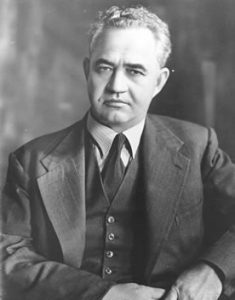Dr J T Hattingh

Dr J T Hattingh – ESCOM Chairman – 1952 – 1962
In 1952, Albert Jacobs retired as Chairman of ESCOM. His successor was an old colleague, Dr J T (Jaytee) Hattingh, ESCOM’s Consulting Engineering and Commissioner since 1949.
ACADEMIC YEARS
He obtained an M.A. degree, with a distinction in Physics, from Rhodes University College in Grahamstown. He then moved on to the University of Cape Town where he obtained a B.Sc degree in engineering. He followed this with a M.Sc and later a D.Sc. His MA thesis was entitled A Universal Stress Sag Chart. This was a practical field guide for the stringing of transmission lines. ESCOM’s engineers and others used this until more modern calculation methods superseded it. ESCOM’s engineers also applied Hattingh’s doctoral thesis, The Behaviour of Three-phase Transmission Systems Having the Neutral Earthed Through a Petersen Coil, to practical network problems.
Dr Hattingh wrote numerous dissertations on problems encountered in the field of electrical engineering. His book “A Universal Sag Chart” enabled the Commission to employ methods which in turn led to a reduction of labour and reduced expenditure.
BUSINESS CAREER
He went to the United States in 1918 and joined the General Electric Company to complete a course in test engineering. Upon his return to South Africa in 1922 he was appointed lecturer in electrical engineering at the Durban Technical College.
In 1923, Dr Hattingh took up a post as lecturer in the physics department of the University of Cape Town.
INTRODUCTION TO ESCOM
He was soon to move again. In 1923, he joined Escom as a junior engineer and after overseeing the construction of Sabie Power Station (which he regarded as one of his “babies”), became Research Engineer at Head Office in 1927. He was appointed as Technical Assistant to Dr H J van der Bijl in 1931 and Consulting Engineer in 1937. In 1949 he became a member of the management team and three years later he was appointed Chairman.
Hattingh was a ‘back-room boy’. He liked to work in his huge, paper-strewn office in ESCOM House, where he acquired a reputation for not suffering fools gladly. He had an abrupt manner when he was busy or preoccupied, making his displeasure clear to callers who outstayed their welcome. When challenged on an issue, he applied a ready tongue and a sharp mind, and often bewildered laymen with his quick reduction of the most intricate engineering problems to a quick graph or diagram.
CHAIRMAN OF ESCOM
The overriding need for a strong technical hand at the helm of ESCOM was still evident, but the shift was towards finding ways to pool and interconnect the ever-growing potpourri of power stations all over the country rather than just building more and more power stations.
Because of his extensive knowledge on most technical issues relating to electricity supply in South Africa, Dr Hattingh’s authoritative advice was widely sought. This led to his appointment as ESCOM Commissioner in 1949. He was quickly tipped to become the next chairman, and spent the next few years honing his skills in other areas of the business.
Dr Hattingh was appointed Chairman of ESCOM in 1952. His first task as chairman was to implement what his predecessor A M Jacobs had planned and started. The long-term solution to the electricity shortage problems lay in building new power stations as fast as possible.
In the period from 1952 to 1959, Escom started the construction of eight new power stations of its own and added boilers and generators to six existing stations.
RETIREMENT
Dr Hattingh’s term as chairman ended on 30 June 1962. He died in 1963 at the age of 68 years.




